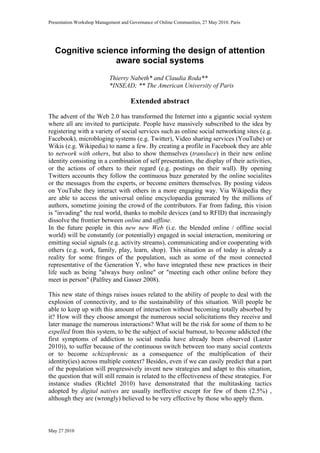
2010.05.27 abstract-cognitive science informing the design of attention aware social systems
- 1. Presentation Workshop Management and Governance of Online Communities, 27 May 2010. Paris Cognitive science informing the design of attention aware social systems Thierry Nabeth* and Claudia Roda** *INSEAD; ** The American University of Paris Extended abstract The advent of the Web 2.0 has transformed the Internet into a gigantic social system where all are invited to participate. People have massively subscribed to the idea by registering with a variety of social services such as online social networking sites (e.g. Facebook), microbloging systems (e.g. Twitter), Video sharing services (YouTube) or Wikis (e.g. Wikipedia) to name a few. By creating a profile in Facebook they are able to network with others, but also to show themselves (transluce) in their new online identity consisting in a combination of self presentation, the display of their activities, or the actions of others to their regard (e.g. postings on their wall). By opening Twitters accounts they follow the continuous buzz generated by the online socialites or the messages from the experts, or become emitters themselves. By posting videos on YouTube they interact with others in a more engaging way. Via Wikipedia they are able to access the universal online encyclopaedia generated by the millions of authors, sometime joining the crowd of the contributors. Far from fading, this vision is "invading" the real world, thanks to mobile devices (and to RFID) that increasingly dissolve the frontier between online and offline. In the future people in this new new Web (i.e. the blended online / offline social world) will be constantly (or potentially) engaged in social interaction, monitoring or emitting social signals (e.g. activity streams), communicating and/or cooperating with others (e.g. work, family, play, learn, shop). This situation as of today is already a reality for some fringes of the population, such as some of the most connected representative of the Generation Y, who have integrated these new practices in their life such as being "always busy online" or "meeting each other online before they meet in person" (Palfrey and Gasser 2008). This new state of things raises issues related to the ability of people to deal with the explosion of connectivity, and to the sustainability of this situation. Will people be able to keep up with this amount of interaction without becoming totally absorbed by it? How will they choose amongst the numerous social solicitations they receive and later manage the numerous interactions? What will be the risk for some of them to be expelled from this system, to be the subject of social burnout, to become addicted (the first symptoms of addiction to social media have already been observed (Laster 2010)), to suffer because of the continuous switch between too many social contexts or to become schizophrenic as a consequence of the multiplication of their identity(ies) across multiple context? Besides, even if we can easily predict that a part of the population will progressively invent new strategies and adapt to this situation, the question that will still remain is related to the effectiveness of these strategies. For instance studies (Richtel 2010) have demonstrated that the multitasking tactics adopted by digital natives are usually ineffective except for few of them (2.5%) , although they are (wrongly) believed to be very effective by those who apply them. May 27 2010
- 2. Presentation Workshop Management and Governance of Online Communities, 27 May 2010. Paris The overall objective of this presentation is to provide some answers to these questions by analysing how to design social systems for the new new Web that are more social attention effective, and therefore support users in allocating their cognitive resources in this online social context. The concept of attention indeed appears to represent a conceptual instrument capable of covering the different elements at the root of the problematic of the new new Web and cognitive science can help in informing the design of such systems. The presentation starts by placing our research in the context of other attention-related research by discussing four main guiding objectives: (1) understanding human attentional processes, (2) defining the economic value of attention, (3) supporting the management of attention in order to ensure effective allocation, and (4) predicting behaviour based on attentional traces. It then focuses on the authors’ work in the design of technologies helping users in their attention allocation (Roda 2010, forthcoming; Roda and Nabeth 2009; Roda and Thomas 2006). In particular we explore methodologies aimed at addressing attentional breakdowns and we illustrate how to provide attentional support in a social system at four key cognitive levels: (1) perception (improving social perception); (2) reasoning (supporting of decision making or planning); (3) execution of actions (facilitating / fluidifying social interaction); (4) metacognition (supporting people in the implementation of more attention-effective social practices). Finally, we look at future research directions in this domain. References Laster, J. 2010, April 28, 2010. Students Denied Social Media Go Through Withdrawal. The Chronicle of Higher Education. Palfrey, J., and Gasser, U. 2008. Born Digital: Understanding the First Generation of Digital Natives: Perseus Books Group: Basic Books. Richtel, M. 2010, March 30, 2010. Only a Few Can Multitask. The New York Time. Roda, C. 2010. Attention support in digital environments, nine questions to be addressed. New Ideas in Psychology, Elsevier, 28(3): 354-364. Roda, C. (Ed.). forthcoming. Human Attention in Digital Environments. Cambridge: Cambridge University Press. Roda, C., and Nabeth, T. 2009. Attention management in organizations: Four levels of support in information systems. In A. Bounfour (Ed.), Organisational capital: Modelling, measuring, contextualising (214-233): Routledge (Advanced research series in management). Roda, C., and Thomas, J. 2006. Attention aware systems: Theories, applications, and research agenda. Computers in Human Behavior, 22(4): 557-587. May 27 2010
